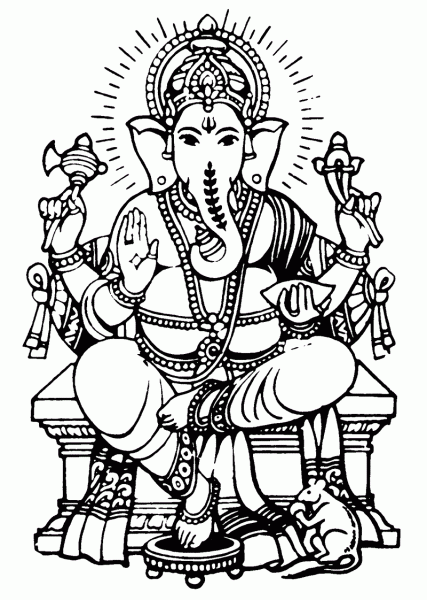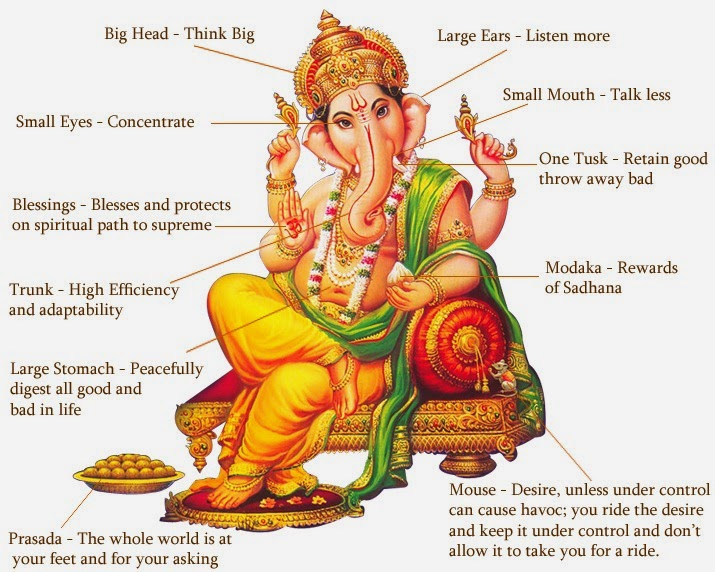Ganesha, also spelled Ganesh, and also known as Ganapati and Vinayaka, is a widely worshipped deity in the Hindu pantheon. His image is found throughout India and Nepal. Hindu sects worship him regardless of affiliations. Devotion to Ganesha is widely diffused and extends to Jains, Buddhists, and beyond India.
Although he is known by many attributes, Ganesha’s elephant head makes him easy to identify. Ganesha is widely revered as the remover of obstacles, the patron of arts and sciences and the deva of intellect and wisdom. As the god of beginnings, he is honoured at the start of rituals and ceremonies. Ganesha is also invoked as patron of letters and learning during writing sessions. Several texts relate mythological anecdotesassociated with his birth and exploits and explain his distinct iconography.
Ganesha emerged as a distinct deity in the 4th and 5th centuries CE, during the Gupta Period, although he inherited traits from Vedic and pre-Vedic precursors. He was formally included among the five primary deities of Smartism (a Hindu denomination) in the 9th century. A sect of devotees called the Ganapatya arose, who identified Ganesha as the supreme deity. The principal scriptures dedicated to Ganesha are the Ganesha Purana, the Mudgala Purana, and the Ganapati Atharvashirsa.
Ganesha has been ascribed many other titles and epithets, including Ganapati and Vighneshvara. The Hindu title of respect Shri (Sanskrit: श्री; IAST: śrī; also spelled Sri or Shree) is often added before his name. One popular way Ganesha is worshipped is by chanting a Ganesha Sahasranama, a litany of “a thousand names of Ganesha”. Each name in the sahasranama conveys a different meaning and symbolises a different aspect of Ganesha. At least two different versions of the Ganesha Sahasranama exist; one version is drawn from the Ganesha Purana, a Hindu scripture venerating Ganesha.
The name Ganesha is a Sanskrit compound, joining the words gana (Sanskrit: गण; IAST: gaṇa), meaning a group, multitude, or categorical system and isha (Sanskrit: ईश; IAST: īśa), meaning lord or master.The word gaņa when associated with Ganesha is often taken to refer to the gaņas, a troop of semi-divine beings that form part of the retinue of Shiva (IAST: Śiva).The term more generally means a category, class, community, association, or corporation. Some commentators interpret the name “Lord of the Gaņas” to mean “Lord of Hosts” or “Lord of created categories”, such as the elements. Ganapati (Sanskrit: गणपति; IAST: gaṇapati), a synonym for Ganesha, is a compound composed of gaṇa, meaning “group”, and pati, meaning “ruler” or “lord”.The Amarakosha, an early Sanskrit lexicon, lists eight synonyms of Ganesha : Vinayaka, Vighnarāja (equivalent to Vighnesha), Dvaimātura (one who has two mothers), Gaṇādhipa (equivalent to Ganapati and Ganesha), Ekadanta (one who has one tusk), Heramba, Lambodara (one who has a pot belly, or, literally, one who has a hanging belly), and Gajanana (IAST:gajānana); having the face of an elephant).
Vinayaka (Sanskrit: विनायक; IAST: vināyaka) is a common name for Ganesha that appears in the Purāṇas and in Buddhist Tantras. This name is reflected in the naming of the eight famous Ganesha temples in Maharashtra known as the Ashtavinayak (aṣṭavināyaka).The names Vighnesha (Sanskrit: विघ्नेश; IAST: vighneśa) and Vighneshvara (विघ्नेश्वर; vighneśvara) (Lord of Obstacles) refers to his primary function in Hindu theology as the master and remover of obstacles (vighna).
A prominent name for Ganesha in the Tamil language is Pillai (Tamil: பிள்ளை) or Pillaiyar (பிள்ளையார்). A. K. Narain differentiates these terms by saying that pillai means a “child” while pillaiyar means a “noble child”. He adds that the words pallu, pella, and pell in the Dravidian family of languages signify “tooth or tusk”, also “elephant tooth or tusk”. Anita Raina Thapan notes that the root word pille in the name Pillaiyar might have originally meant “the young of the elephant”, because the Pali word pillaka means “a young elephant”.
In the Burmese language, Ganesha is known as Maha Peinne, derived from Pali Mahā Wināyaka.The widespread name of Ganesha in Thailand is Phra Phikhanet or Phra Phikhanesuan, both of which are derived from Vara Vighnesha and Vara Vighneshvara respectively, whereas the name Khanet (from Ganesha) is rather rare.
In Sri Lanka, in the North-Central and North Western areas with predominantly Buddhist population, Ganesha is known as Aiyanayaka Deviyo, while in other Singhala Buddhist areas he is known as Gana deviyo.






